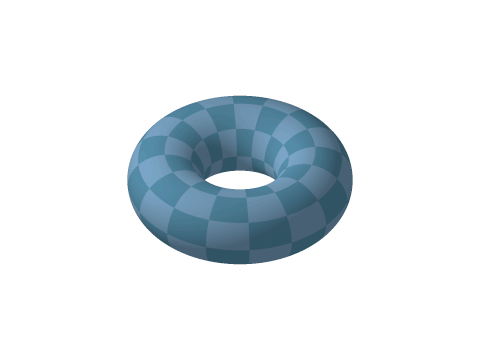
Above animation is very helpful to visualize the Villarceau Circles. Another simple way to show the Villarceau circles is using the fundamental polygon representation where a torus is represented as a rectangle whose opposite edges are glued together. In the polygon represetnation, the horizontal and vertical edges are the two normal circles (horizontal and vertical circles). The two diagonals are the Villarceau circles as depicted in the following diagram:

We know that RPM algorithm simulates a multi-particle dynamic system confined on the flat torus surface. For some unknown reasons, RPM maps often form symmetry patterns alone the diagonal lines, e.g. along the Villarcea circles. For instance, when we map the sphere to the tours, RPM algorithm cuts the sphere into two equal sized half and map them as two discs to the torus surface. The two discs are positioned alone a a diagonal line as depicted in the following picture:

We see in above picture that only one disc is completely displayed as a whole, the other one has been cut by the edges into 3 or 4 pices (which will form a complete disc when we glue the opposite edge together). The whole picture is more or less symmetric with respect to the left-up-to-right-bottom diagonal line. We can get a better visualization of above image when we tile multiple copies of above map together as be show in the following picture:

Now, it would be helpful for the purpose of visualization if we can show the two discs as whole discs in a single map without using the tiling techniques. We can achieve this by transforming the coordinator from the two vertical and horizontal edges to the two diagonals (i.e. the two Villarceau circles). The transformation is schematically depicted in the following diagram:

We call the above transformation the diagonal rotation as it basically rotate the coordinator to the diagonals. Formally, the diagonal rotation is done by the following forms:

In above forms w and h are the width and height of the fundamental rectangle respectively. d is the length of its diagonal. The above forms transforms points from the region D to D'. For points from other regions, we have to apply some simple shifting after the transformation as indicated in Figure 5.
As indicated in Figure 5, the two diagonals will become the edges of the transformed map. Thus, in order to avoid the resulting map be cut off by the edges we should shift a RPM map away from the diagonals through torus cyclical shifting. For our sphere example we can shift the map, for instance, to the following position:

When we now apply the diagonal rotation on the map in Figure 6 we will get the following rotated map:

Comparing with the original RPM map in Figure 3, the rotated map in figure 7 is obviously easier to investigate for human eyes.
It should be pointed out that a RPM map after diagonal rotation is no long a torus map in the sense that you cannot tile the map to fill 2D space the same way as be shown in Figure 4. Since this will break the edge-connectivity as indicated in Figure 5. But you can fill the 2D space with the rotated RPM map like building a bridge wall: you tile the map site by site to build a continuous lay, then build next lay the same while shift the lay to the left (or right) for half block. The following picture depicts this characteristics:
